EPCQ128ASI16N Intel: Package, Applications and Datasheet
2025-03-27 10:26:55 442
EPCQ128ASI16N Description
The EPCQ128ASI16N is a 128 Mb (16 MB) configuration memory device designed for Intel® FPGAs (primarily Cyclone®, Arria®, and Stratix® series). Packaged in a compact 16-pin SOIC, it offers reliable, high-speed, non-volatile storage to load FPGA configuration data upon power-up. The EPCQ family provides a streamlined interface for FPGA booting, while maintaining high system integrity and efficient memory utilization.
EPCQ128ASI16N Features
Memory Capacity: 128 Mb (16 MB) of serial configuration flash memory
SPI Interface: Quad SPI (Serial Peripheral Interface) for faster data throughput
High-Speed Configuration: Supports fast FPGA boot-up with x1, x2, and x4 data modes
Security Support: Secure data storage with protection against accidental overwrites
Endurance & Retention: 100,000+ erase/program cycles, 20+ years data retention
Low Power Operation: Efficient standby and active current profiles
Package: 16-pin SOIC (Small Outline Integrated Circuit), RoHS-compliant
Compatible with Intel Quartus Prime software for seamless FPGA integration
EPCQ128ASI16N Applications
FPGA Boot Configuration for Cyclone IV, V, MAX 10, and Arria series
Embedded Systems requiring reprogrammable boot flash
Industrial Automation devices with mission-critical bootloaders
Secure Boot Applications in networking and data communication
Consumer Electronics needing fast, reliable startup memory
Automated Test Equipment (ATE) and high-reliability systems
EPCQ128ASI16N CAD Model
Symbol
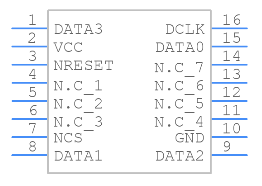
Footprint
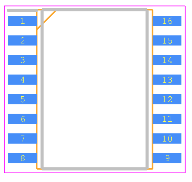
3D Model
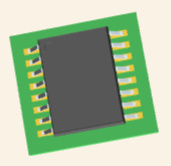
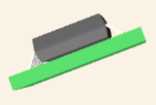
EPCQ128ASI16N Package
16-Lead SOIC (Small Outline Integrated Circuit) – Wide Body
Package Type: SOIC-16W
Body Width: 7.5 mm
Pitch: 1.27 mm (lead-to-lead spacing)
Mounting Type: Surface Mount (SMT)
RoHS Compliant: Yes
This wide-body SOIC-16 package offers a good balance of compact size and ease of PCB routing, making it suitable for space-sensitive FPGA-based designs.
EPCQ128ASI16N Alternatives
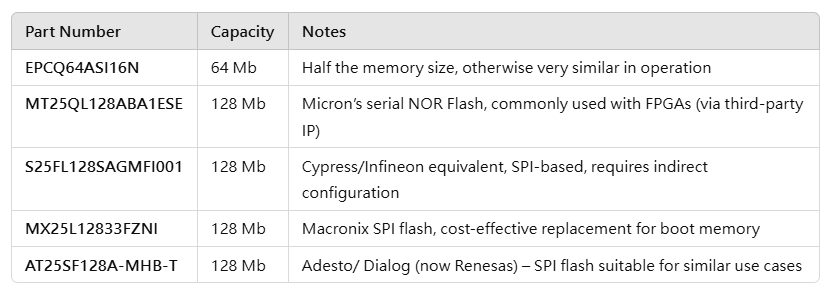
Figure. 1
EPCQ128ASI16N Manufacturer
Intel Corporation is a global leader in semiconductor innovation, renowned for shaping the future of computing and technology. Founded in 1968 and headquartered in Santa Clara, California, Intel designs and manufactures cutting-edge microprocessors, integrated circuits, and system-on-chip (SoC) solutions that power everything from personal computers and servers to advanced embedded systems and cloud infrastructure.
As the inventor of the x86 architecture, Intel has been instrumental in driving the evolution of computing over the past five decades. Today, the company is also a major player in AI acceleration, networking, autonomous driving, and FPGA (Field-Programmable Gate Array) technologies, especially after its acquisition of Altera Corporation in 2015.
With a strong focus on innovation, sustainability, and digital transformation, Intel continues to lead in delivering intelligent solutions that connect, analyze, and power the modern world.
EPCQ128ASI16N FAQs
Can EPCQ128ASI16N be used with all Intel FPGAs?
Answer: No. It is compatible with most Intel FPGAs that support Active Serial (AS) configuration mode, including Cyclone IV/V, MAX 10, and Arria series. Not suitable for FPGAs requiring JTAG-only boot.
What programming tools support EPCQ128ASI16N?
Answer: Intel's Quartus Prime software supports programming and configuration of the EPCQ128ASI16N via USB-Blaster or ByteBlaster programming cables.
How fast is the configuration process using x4 (quad-SPI) mode?
Answer: The maximum clock frequency is typically up to 100 MHz, and with quad-SPI (x4) enabled, the FPGA can be configured significantly faster compared to traditional single-bit serial flash.
Is in-system reprogramming supported?
Answer: Yes. The EPCQ128ASI16N supports in-system programming (ISP) through the Active Serial interface, which allows firmware updates without removing the chip from the board.
Can it store multiple images or partial reconfiguration files?
Answer: Yes, if the FPGA and design support it. The 128 Mb capacity allows multiple configuration images or room for partial reconfiguration files, especially in large-scale designs.




